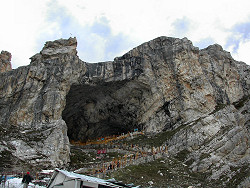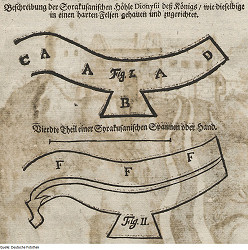Shri Amarnath Ji Yatra
Amarnath Cave
Useful Information
| Location: |
On Mount Amarnath, at the farther end of Lidder valley, Kashmir, Northern India.
45 km from Pahalgam, 141 km from Srinagar. Access from Panchtarni, 6 km walk. (34.215670, 75.504235) |
| Open: |
JUL and AUG daily all day. [2021] |
| Fee: |
free. [2021] |
| Classification: |
 Karst Cave
ice cave. Karst Cave
ice cave.
 Highest Show Caves Highest Show Caves
|
| Light: |
 Incandescent Incandescent
|
| Dimension: | A=3,888 m asl, L=27 m, H=45 m. |
| Guided tours: | self guided. V=544,000/a [2008] |
| Photography: | allowed |
| Accessibility: | no |
| Bibliography: |
The Hindu Holy Cave of Amarnath,
The British Caver 1971 Vol 56 p 68
|
| Address: | |
| As far as we know this information was accurate when it was published (see years in brackets), but may have changed since then. Please check rates and details directly with the companies in question if you need more recent info. |
|
History
| AUG-1996 | 260 people died on their pilgrimage in the wake of a storm. |
Description


अमरनाथ (Amarnath Cave) is named after Mount Amarnath (5,486 m asl), where it is located almost 4,000 m high. Because of this height, the cave is covered with snow for most of the year. Only for a short period during sommer, the entrance is accessible. The cave is an ice cave, containing a certain amount of ice stalagmites. It was discovered by Bregish Reshi.
The cave is a holy place for Hindu pilgrims, because of its ice content. One very characteristic pillar of ice is believed to be an ice lingham or lingam, the phallic symbol of Lord Shiva. Hence, the cave is also called Shivas Cave. Two smaller ice stalagmites represent Parvati, his wife, and Ganesha, his son. The Hindu pilgrims also believe, that the height of the lingham increases and decreases with the phases of the moon. This is a swayambhu Shivalinga, a naturally formed Shiva linga, not an artificial one.
A legend tells, that Shiva explained the secret of creation to Parvati in the cave. Two mating doves heard this and now live in the cave for eternity, being reborn again and again. This legend is confirmed (at least in the eyes of believers) by flocks of doves near the cave, with no vegetation around. Another legend tells that Kashyap Reshi drained a big lake, which became then the Kashmir valley of today.
Goddess Maa Parvati asked Lord Shiva why he was wearing a mund mala (garland of heads).
Lord Shiva replied that every time Parvati is reborn, he adds a head to his garland.
Puzzled by this enigmatic revelation, Parvati asked him why he is immortal while she dies and is reborn.
He told her that she must listen to the Amar Katha, the story of immortality, to understand this mystery.
Parvati agreed and Lord Shiva searched for the right place for such a cosmic discourse.
Looking for a lonely place, far away from the reach of all living beings, he finally chose Amarnath cave.
In utmost secrecy, Lord Shiva parted with his faithful Vahana, Nandi, in Pahalgam.
In Chandanwari, he freed the moon (chand) from its matted locks (jata).
On the shores of Sheshnag Lake, he freed the snakes, and until today the Sheshnag area is surrounded by seven identical peaks representing the seven-headed Sheshnag.
Lord Ganesha was left behind at Mahagunas Parvat.
At Panjtarni, Lord Shiva gave up the five elements (earth, water, air, fire and sky) which constitute the essence of life and of which he is the supreme lord.
Finally, Lord Shiva entered Amarnath cave with Parvati Maa and both entered into a state of Samadhi (deep meditation).
To ensure absolute secrecy and to prevent any living being from knowing the immortal story, Lord Shiva created Kalagni and ordered him to spread a blazing fire to extinguish every living being in and around the sacred cave.
When the stage was set for the unveiling, Shiva began to tell Maa Parvati the secret of immortality.
However, it is said that she eventually fell asleep while a pair of pigeons staying in the cave overheard the celestial discourse.
These doves themselves became immortal.
Even today, pilgrims can sometimes see a pair of doves in the cave, despite the high altitude and freezing temperatures.
And so this cave became a sacred place of Shiva-Parvati and one of the holiest places in Hinduism.
The cave is also considered one of the 51 Shaktipeethas.
Every year in Juli and August, while is accessible for a period of two months, thousands of Hindus go on a pilgrimage up to the cave. In 2008, it were about 544,000 in two months, that’s almost 9,000 visitors daily. The peak is in the month of Shravan, on the full moon in August, when the lingam is said to reach its biggest size. The pilgrimage ends with the arrival of Lord Shiva’s mace, known as Charri Mubarak. A traditional puja is performed inside the cave formally bringing the annual pilgrimage to a close. Then the holy mace is returned to its seat inside the Dashnami Akhara temple.
The pilgrimage is a thread to the cave and the ice, as hundreds of people and their candles increase the temperature and change the climate of the small cave. The warmth causes the lingam to melt. Rumours of artificially enhanced lingams by adding cold water regularly cause disputes and are reported in Indian news. The pilgrimage is a great opportunity to make money by providing food, beverages, clothes, and any other kind of goods. This merchandising business is dominated by a few groups which regularly start fighting about it.
But the strangest aspect of the pilgrimage is the enormous death toll it causes every year, e.g. 45 in 2008. The big height and the low temperature, combined with the under-nourished state of many people, are responsible for dozens of dead pilgrims every year. Sometimes, like in 1996, bad weather increases the number of fatalities dramatically.
- See also
 Search DuckDuckGo for "Amarnath Cave"
Search DuckDuckGo for "Amarnath Cave" Google Earth Placemark
Google Earth Placemark Amarnath Temple - Wikipedia (visited: 08-MAY-2025)
Amarnath Temple - Wikipedia (visited: 08-MAY-2025) The complete story of Amarnath Cave Temple: a mystical natural shivling formed from Himalayan ice (visited: 08-MAY-2025)
The complete story of Amarnath Cave Temple: a mystical natural shivling formed from Himalayan ice (visited: 08-MAY-2025) Shri Amarnathji Cave (visited: 08-MAY-2025)
Shri Amarnathji Cave (visited: 08-MAY-2025) Amarnath Cave und der heilige Lingam Shivas
Amarnath Cave und der heilige Lingam Shivas  (visited: 08-MAY-2025)
(visited: 08-MAY-2025)
 Index
Index Topics
Topics Hierarchical
Hierarchical Countries
Countries Maps
Maps